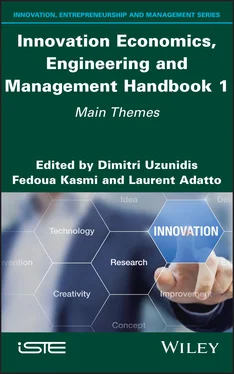1 Cover
2 Title Page
3 Copyright First published 2021 in Great Britain and the United States by ISTE Ltd and John Wiley & Sons, Inc. Apart from any fair dealing for the purposes of research or private study, or criticism or review, as permitted under the Copyright, Designs and Patents Act 1988, this publication may only be reproduced, stored or transmitted, in any form or by any means, with the prior permission in writing of the publishers, or in the case of reprographic reproduction in accordance with the terms and licenses issued by the CLA. Enquiries concerning reproduction outside these terms should be sent to the publishers at the undermentioned address: © ISTE Ltd 2020 ISTE Ltd 27-37 St George’s Road London SW19 4EU UK USA www.iste.co.uk John Wiley & Sons, Inc. 111 River Street Hoboken, NJ 07030 www.wiley.com © ISTE Ltd 2021 The rights of Dimitri Uzunidis, Fedoua Kasmi and Laurent Adatto to be identified as the authors of this work have been asserted by them in accordance with the Copyright, Designs and Patents Act 1988. Library of Congress Control Number: 2021932077 British Library Cataloguing-in-Publication Data A CIP record for this book is available from the British Library ISBN 978-1-78630-456-8
4 Introduction: General Presentation
5 1 Economy – Innovation Economics and the Dynamics of Interactions
1.1. Introduction 1.2. The definition of innovation and the primacy of J.A. Schumpeter’s work 1.3. How can we measure innovation, in all its forms? 1.4. From the entrepreneur to the multiple actors of innovation 1.5. Innovation policies and the innovation system 1.6. Conclusion 1.7. References
6 2 Management – Managing Innovation According to Space, Time and Matter2.1. Introduction 2.2. Managing innovation: a question of space 2.3. Managing innovation: a matter of time 2.4. Managing innovation: a question of matter 2.5. Conclusion 2.6. References
7 3 Agriculture – Agricultural and Food Innovations and Agro-ecological Transition3.1. Introduction 3.2. Two centuries of agricultural revolution without “innovation” 3.3. The green revolutions driven by linear and technological innovation design 3.4. The notion of innovation in the face of agricultural and food transitions 3.5. Sector specificities of innovation in agriculture and food 3.6. Conclusion 3.7. References
8 4 Anthropology – Anthropological Aspects of Innovation: Defining Benchmarks4.1. Introduction 4.2. Innovation, a total social phenomenon, between invention, diffusion and reception 4.3. The force of constraints or innovation as a process of insertion in a field of contradictory forces 4.4. Conclusion 4.5. References
9 5 Business – Business Creation and Innovative Entrepreneurial Ecosystems 5.1. The company, the territory and the ecosystem 5.2. From the business ecosystem to the entrepreneurial ecosystem: polymorphous innovation dynamics? 5.3. References
10 6 Capacity – Innovation Capacities and Learning Dynamics6.1. Introduction 6.2. Learning and innovation capacities 6.3. The diversity of innovation capacities 6.4. Capacities, innovation system and competency building 6.5. Conclusion 6.6. References
11 7 Capital – Knowledge Capital and Innovation: Production and Use of Knowledge in Companies7.1. Introduction 7.2. Knowledge capital: toward an understanding of the innovation process 7.3. Knowledge capital, tangible and intangible assets 7.4. Knowledge capital and knowledge management within organizations 7.5. Knowledge capital and open innovation 7.6. Conclusion 7.7. References
12 8 Cluster – Innovative Cluster: Geographical and “Virtual” Proximity in the Digital Era8.1. Introduction 8.2. Innovative clusters: the matter of geographical and “virtual” proximity 8.3. Innovative clusters and the Internet and information and communication technologies revolution 8.4. Conclusion 8.5. References
13 9 Collaboration – Collaborative and Open Innovation in Highly Competitive Contexts9.1. Introduction 9.2. Literature review 9.3. Collaborative innovation and innovation ecosystems 9.4. Open innovation versus closed innovation 9.5. Conclusion 9.6. References
14 10 Creativity – Creativity for Innovation: A Mutually Advantageous Relationship10.1. Introduction 10.2. Increasingly “creative” representations of innovation 10.3. Impacts on creativity of its integration in the field of innovation 10.4. The same shared complexity 10.5. References
15 11 Cycles – The Long Cycles of the Economy and the Question of Innovation11.1. Introduction 11.2. The conditions for cyclical economic development: the key role of innovation 11.3. Historical time and periodization of the economy 11.4. Conclusion 11.5. References
16 12 Design – Innovative Design: The Importance of a Methodical Approach12.1. Introduction 12.2. What methods should be used to cultivate disruptive innovation in the 21st century? 12.3. Conclusion 12.4. References
17 13 Diffusion – Diffusion and Adoption Behavior of Innovations13.1. Introduction 13.2. The epidemiological approach 13.3. The discrete choice approach 13.4. Public dissemination policies 13.5. Some extensions of the analysis: multiplicity of innovations and institutional framework 13.6. Conclusion 13.7. References
18 14 Disruption – Disruptive Innovation and the Evolution of Competitive Relationships14.1. Introduction 14.2. The disruptive innovation model 14.3. The innovator’s dilemma 14.4. References
19 15 Ecosystem – Innovation Ecosystem: Generativity, Resilience and Power of Attraction15.1. Introduction 15.2. Theoretical approaches of an innovation ecosystem 15.3. Main features of innovation ecosystems 15.4. Conclusion 15.5. References
20 16 Entrepreneur – The Innovative Entrepreneur as an Actor of Economic Change16.1. Introduction 16.2. The entrepreneur as an actor of change 16.3. The evolution of the function of the innovative entrepreneur 16.4. References
21 17 Financing – Financing R&D and Innovation17.1. Introduction 17.2. Information asymmetries and sources of funding 17.3. Reasons for funding reluctance 17.4. Public intervention in finance innovation 17.5. Venture capital 17.6. Conclusion 17.7. References
22 18 Frugality – Frugal Innovation as Inclusive Innovation18.1. Introduction 18.2. Frugal innovation as a new technological paradigm 18.3. Case studies 18.4. Frugal innovation and similar approaches 18.5. Frugal innovation as an environmental innovation 18.6. Frugal innovation and sustainability 18.7. Drivers of frugal innovation: demand-pull and competition effects 18.8. Conclusion 18.9. References
23 19 Future – The Future of Innovative Technologies: Between Imagination and Technological Ideology19.1. Introduction 19.2. A paradigmatic convergence 19.3. Technological revolution: the imagined future 19.4. Conclusion 19.5. References
24 20 Hybridization – Hybridization of Tech-Push and Market-Pull Approaches in Innovation Processes20.1. Introduction 20.2. Definitions of Tech-Push and Market-Pull in the implementation of innovation processes 20.3. The nine demand readiness level (DRL) stages 20.4. Hybridization and agility of innovation processes 20.5. DRL-TRL and its applications to the hybridization dynamics of Tech-Push and Market-Pull approaches 20.6. Impacts of DRL-TRL 20.7. Conclusion 20.8. References
25 21 Incentives – Incentives for Innovation: Diversity and Public-Private Combinations21.1. Introduction 21.2. The incentive for innovation and its forms 21.3. Diversity of applications of incentive forms 21.4. Conclusion 21.5. References
26 22 Indicators – The Complexity of Innovation Indicators22.1. Introduction 22.2. Presentation of innovation indicators: input and output approach 22.3. Main limitations of innovation indicators 22.4. Conclusion 22.5. References
27 23 Information – Information for Innovation: Strategic, Competitive and Technological Intelligence23.1. Introduction 23.2. The monitoring concept 23.3. “Traditional” monitoring and innovation 23.4. The search for information and innovation 23.5. Creative monitoring 23.6. Strategic innovation monitoring 23.7. Conclusion 23.8. References
Читать дальше












